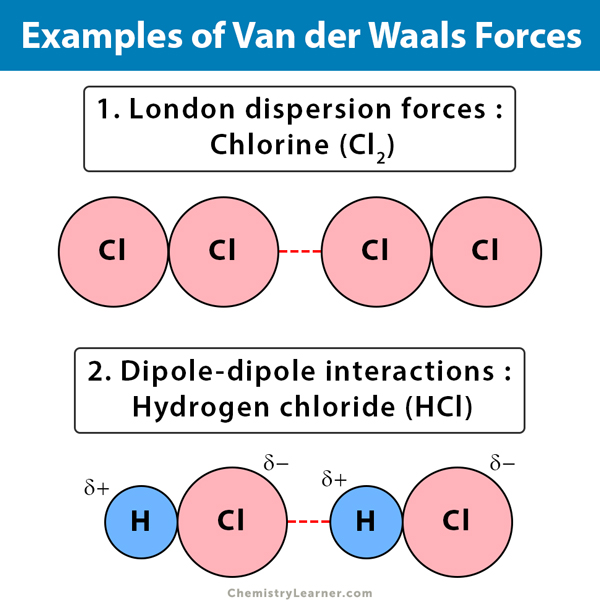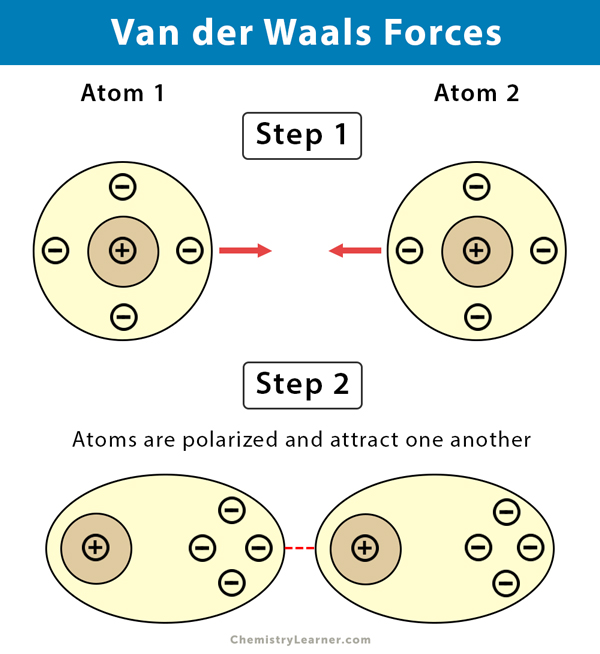Van der Waals Forces
Table of Contents
What are van der Waals Forces?
Van der Waals forces, also known as van der Waals bonds or van der Waals interaction, are weak intermolecular interactions observed in condensed phases like solid and liquid. They are responsible for the bulk properties of substances, like the boiling and melting points. Van der Waals bonds are secondary bonds in molecules where ionic and covalent bonds form the primary bonds.
The history of this force goes back to 1923 when Dutch physicist Johannes Diderik van der Waals postulated its existence.
How do van der Waals Forces Hold Molecules Together?
Van der Waals forces occur due to the fluctuations in the charge density of particles. As a result, an atom or molecule is polarized with positive charges at one and negative charges at the other end. The polarization gives rise to electrostatic forces between the two atoms or molecules. These weak forces are responsible for holdings the atoms or molecules together. Van der Waals forces disappear as the distances between the atoms or molecules increase [1-7].
Van der Waals radius is the radius of an imaginary sphere surrounding an atom. It represents the distance of the closest approach for another atom. In other words, van der Waals radius is one half of the distance of separation between the center of the two approaching nuclei. It is a parameter that determines whether the atoms or molecules will hold together in a solid or liquid.
Properties of van der Waals Forces
Here are some characteristics of the van der Waals forces [1-7].
- Additive, i.e., several intermolecular interactive forces add together to form a quantifiable force
- Non-directional, i.e., they can attract atoms or molecules from all direction
- Weaker than ionic and covalent chemical bonds
- Act only over a short range. The interaction is significant when molecules are positioned closer.
- Independent of temperature, except dipole-dipole interactions
Types of van der Waals Forces
There are two types of van der Waals forces [1-7].
1. London Dispersion Forces
London dispersion forces are intermolecular forces that occur between two atoms or two nonpolar molecules due to the motion of electrons. An atom consists of a nucleus and electrons that move in orbits. At any time, the electrons can cluster around one part of the atom. As a result, the atom becomes negatively charged at one end and positively charged at the other end, resulting in an instantaneous dipole. This weak and temporary dipole then influences neighboring atoms through electrostatic attraction and repulsion, thereby inducing dipoles. The induced dipoles are feebly attracted to one another. The strength of dispersion forces increases as the number of electrons in the atoms or nonpolar molecules increases.
These forces are named after Fritz London, who first proposed their existence in 1930.
Example: Helium (He), chlorine (Cl2), and carbon tetrachloride (CCl4)
2. Dipole-dipole Interactions
The dipole-dipole interactions or dipole-dipole forces arise because of the electric polarization induced particles due to the presence of other particles. They are similar to London Dispersion forces, but they occur in molecules that have a permanent dipole. Here, the negative end of a polar molecule attracts the positive end of another polar molecule. This attraction between these two molecules is known as the dipole-dipole force.
Hydrogen bonding is a particular type of dipole-dipole interaction.
Examples: Water (H2O) and hydrogen chloride (HCl)

Factors Affecting van der Waal Forces
Two factors affect the van der Waals forces:
1. Number of Electrons Held by the Atom or Molecule
The strength of van der Waals forces depends primarily on the number of electrons in the atom or molecule. So, larger atoms and molecules will have greater forces.
2. Shape of the Molecule
For isoelectronic molecules, i.e., isomers with the same number of electrons, the factor that determines the strength of the van der Waals force is the shape of the molecule and the area of surface contact. If the isomer is branched, then the molecules are closely packed. In this case, the van der Waals forces will be weak.
Van der Waals Forces in Real Life
1. Gecko
Van der Waals forces are essential in Gecko. Gecko uses van der Waals forces to stick on surfaces and climb walls. They have setae on the pads of their feet, allowing them to climb extremely smooth surfaces like glass. This force comes from fluctuations in charge distributions between neighboring molecules. The charge fluctuations are in synchronization, thereby creating an attractive force.
2. Graphite
Van der Waals forces bonds the different graphite layers using dispersion forces. Graphite is arranged in several layers of thin sheets. Between each layer, there are van der Waals intermolecular forces that are weak in comparison to the regular C-C covalent bonds. For each carbon atom, there is a delocalized electron since carbon only forms three bonds. As all the delocalized electrons move around in the sheet, very large temporary dipoles will induce opposite dipoles in the sheets above and below. Eventually, the induced dipole will be present throughout the whole crystal.
Importance of van der Waals Forces
Here are the importance and applications of van der Waals forces [8]:
- Helps in stabilizing the protein structure
- Responsible for stability of polymer chain
- Account for the cohesion of inert gases in solid and liquid states
- Accounts for physical adsorption of molecules to solid surfaces
- Responsible for adhesion and stability of colloids
FAQ
Ans. Ionic bonds and van der Waal forces are similar in some way. In both cases, the attraction is formed due to the oppositely charged regions.
